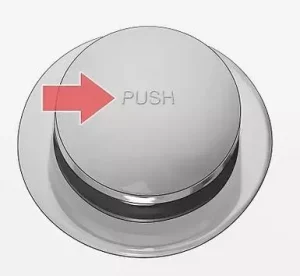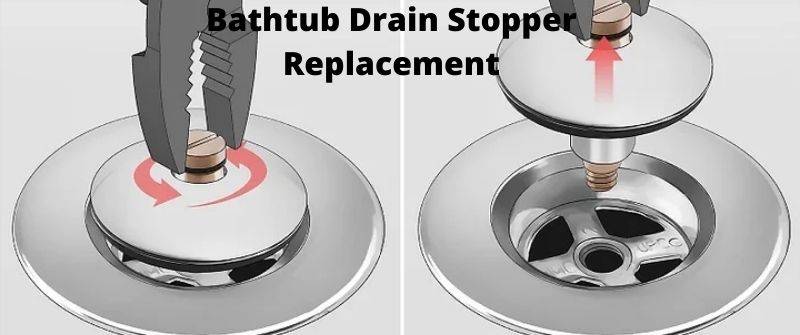The bathtub drain stopper is a vital part of the bathtub. It keeps water from leaking out of your tub, allowing it to be filled and then emptied again. Once in a while, you should remove the drain stopper to clean it and make any necessary repairs. Routine maintenance occasionally necessitates the replacement of the stopper.
When to Replace Bathtub Drain Stopper
Bathtub stoppers, like any other plumbing component, require regular maintenance. Some have worn-out rubber seals and can become inoperable when soap and hair plug the drain.

You must frequently remove the stopper to undertake this maintenance.
Slow drains are one of the most prevalent plumbing problems in the home, and they can be a real pain.
It is probably time for a bathtub drain replacement if your tub drains slowly or if you notice any damage to your drain.
How to Replace a Bathtub Drain Stopper
It should only take approximately an hour to remove and replace your bathtub drain. Make sure you have the necessary parts and equipment on hand before you begin, including:
- Drain key
- Putty knife
- Plumber’s putty
- Rubbing alcohol
- New drain assembly
- Flathead screwdriver
Step 1: Take out the old stopper
Begin by removing the old bathtub drain assembly and ensuring that it is clear of any obstructions. Open the drain and turn the foot lock stopper counter-clockwise until it comes loose. You can now detach the stopper. It is also simple to remove lift-and-turn drain stoppers.
Unscrew any screws on your model until the stopper comes loose. If you can’t find any screws, try rotating it counterclockwise to loosen it. In the case of a lever stopper, remove the screws that hold the overflow plate, linkage rod, and plunger. Then unscrew and take out the drain plate.
Step 2: Detach the drain flange
The drain flange should now be visible, and you have to remove it before installing a new drain assembly. Using a specialized drain key is the simplest way to do so. Pull out the flange by turning it counterclockwise. You can get a drain key in most DIY stores for a reasonable price.

Remove the plumber’s putty from around the drain using a putty knife after removing the flange.
You can pour the small putty particles down the drain, but you must throw away the large chunks.
Scrape the putty away with caution to prevent scratching your bathtub. If the putty is tough to remove, try rubbing alcohol.
Step 3: Install the new flange
Begin by forming a sausage shape out of a thin piece of plumber’s putty. Then, firmly push it around the edge of the new flange to help form a strong, waterproof seal. A rubber gasket is included in some bathtub drain assemblies.
If yours has one, place it around the drain’s edge before inserting the new flange.
Screw the flange clockwise with the drain key until you get a tight seal between the drain and the drain pipe. If you overtighten the flange, it will be difficult to remove when it comes time to repair or replace it.
Step 4: Insert the new stopper
If your new assembly comes with a separate bathtub drain stopper, screw it clockwise into the flange to attach it. Lever drains include a plunger and connection that have to go into the overflow pipe.
Make sure the assembly you intend to purchase is the right size for your bathtub. Finally, make sure the bathtub drain assembly is waterproof.
Close the bathtub drain stopper and turn on the faucet to fill the tub with a few inches of water. Leave it for a few hours, checking now and then to ensure the water level stays the same.
If it doesn’t, look for any gaps or loose connections in the seal and reseal with more plumber’s putty if needed.
Different Types of Bathtub Drain Stoppers
The most common types of bathtub drain stoppers include:
1. Lift-and-turn
A lift-and-turn drain stopper is a basic design that requires little maintenance. Aside from lifting the plug to clear the drain of hair and debris now and then. A little knob on the drain stopper’s cap that works to open and close the stopper distinguishes it.
Close a lift-and-turn stopper by rotating the knob on the top of the stopper until it goes down, and open it by raising and oppositely turning the knob.
2. Push-and-pull
A push-and-pull stopper is a relatively basic mechanical construction that rarely needs repair. It has a similar design and appearance to a lift-and-turn stopper. However, instead of twisting to open and close, it’s pushed down to close and pulled up to open.
The stopper body is linked to the drain by a setscrew situated under the stopper cap.
3. Pop-up
You have to withdraw the stopper and rocker arm through the drain opening. The connecting rod linkage must be retrieved up through the overflow pipe and out through the overflow plate when cleaning a pop-up stopper.
Because of the complexity of the mechanism, this stopper is more prone to accumulating hair and dirt.
4. Toe-touch

A toe-touch stopper is similar to a lift-and-turn stopper and a push-and-pull stopper. A screw beneath the stopper cap holds the stopper body in place to the crossbar on the drain fitting.
To close or open the stopper, press down on it with your toe. It is relatively trouble-free, though it may need replacement if the spring mechanism wears out.
5. Flip-it
A flip-it tub stopper is simple to install and requires no tools. A toggle lever attached to the top of the stopper is pushed from side to side to open or close it. Push this sort of stopper down the drain, and the built-in O-rings keep it in place and provide a watertight seal.
6.Trip lever
The trip lever stopper is one of two varieties with a lever on the front of the tub’s overflow plate. The drain aperture has a strainer, but no visible pop-up stopper in the first style.
This stopper works by moving a plunger up and down in the tub overflow pipe. It closes and opens the tub’s drain pipe. A connecting rod within the overflow tube connects the plunger to the trip lever.
Best 3 Bathtub Drain Stoppers
Different bathtubs will necessitate the usage of various drain stoppers. The majority of drain stoppers, on the other hand, can be used with any bathtub.
As a result, you should choose the option that requires the least amount of maintenance and installation. The top three bathroom drain stoppers include lift and turn, toe-touch, and push-Pull stoppers.

As a homeowner, I am specifically keen on home improvement. I am passionate about homes, yards, and home improvement. I blog on home ideas and reviews on solutions that make homes better.
